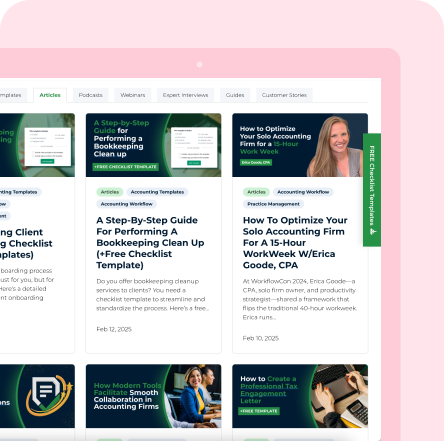S01 E02: A Single Strategy That Can Turn This Accounting Firm’s Management Style Around
Guest: Roman Villard, Kellie Parks & Shahram Zarshenas

Podcasts » S01 E02: A Single Strategy That Can Turn This Accounting Firm’s Management Style Around
The Workflow Roast is where firms’ workflow strategies are reviewed, and solutions are given right on the spot. In this episode, Roman Villard and Kellie Parks share the key strategy that can dramatically improve firm management for accounting and bookkeeping practices.
From optimizing workflows to creating better systems for client and team management, Roman and Kellie offer practical tips to help firms run smoother, more efficiently, and with less risk.
Whether you’re struggling with client onboarding, payment processes, or organizing your firm’s operations, this episode breaks down how to implement a strategy that can make a real impact on your business.
What You’ll Learn:
– Best practices for efficient firm management
– Tools to streamline workflow and task delegation
– Tips for balancing growth with operational control
– Managing client expectations while protecting your firm’s time and resources
Tune in!
Timestamps
Firm Management and Productivity Efficiency (0:00)
Live Commentary and Time Tracking Workflows (2:38)
Batch Processing and Time Tracking Best Practices (3:59)
Handling Client Workflow Issues and Pricing Strategies (16:51)
Pricing Strategies and Client Expectations (20:09)
AB Testing and Pricing Adjustments (25:39)
Menu-Based Pricing and Client Success (28:05)
Roman Villard:
All right, we should be live for another Workflow Roast. We have a special guest today, the CEO and founder of Financial Cents, Shahram Zarshenas.
Shahram Zarshenas:
Thanks for having me. I’m excited to be here. Just don’t roast me too hard, please!
Roman Villard:
So, Kellie Parks typically joins this segment, and she should be joining us shortly. Kelly and I were under the impression we were going to be roasting Shahram today, but apparently, that’s not the plan! Instead, we’ll be talking about firm management and some of the feedback we received after our last episode. We’ll dive into firm management issues and how to handle them.
Shahram Zarshenas:
Yeah, but if Kelly shows up late, we’re definitely going to roast her!
Roman Villard:
Absolutely! But what’s cool is that you, Shahram, have a unique perspective on firm management, having built a firm management software. You’ve seen firsthand how firms structure workflows and templates. Before we dive in, do you have any initial thoughts on how to run a successful practice?
Shahram Zarshenas:
Definitely! One of the key things to focus on is productivity and efficiency. When you’re just starting out, those might not be top of mind, but as you grow and hire more team members, small productivity improvements—say 10 to 20%—really add up. Over time, that increase in productivity can be equivalent to adding an extra person to your team, without having to actually hire someone. It’s all about building these processes into your firm’s DNA from the beginning.
Roman Villard:
I completely agree. Just last year, we had three people, and now we’re up to 11. Implementing change in a larger team is definitely harder, so starting early with solid processes can set you up for long-term success. It’s easier to manage growth if these systems are already in place.
Shahram Zarshenas:
Exactly. It might seem easier to skip those steps when you’re small, but it’s always harder to change things later. If you lay the groundwork early, it pays off in the long run.
Roman Villard:
100%. We’ve got live commentary going on, so if anyone has questions about firm management or workflow, please drop them in the comments, and we’ll get to them shortly. We already have two submissions we’re going to walk through today from a firm management workflow perspective, but we’re open to hearing more. This is a roast—but we’ll try to be helpful!
Shahram Zarshenas:
Yeah, I have to admit, I’m not very good at roasting people.
Roman Villard:
All right, well, why don’t we dive into our first submission? Let me share my screen here. Okay, I’ll read this out for those listening:
“If you keep track of your time by client, whether you bill hourly or just for internal tracking, what does your workflow look like? Do you track time every time you sit down to work on a client, or do you batch tasks together? How do you handle clients with low activity—do you do a little bit every day or batch it weekly? I’m looking for ideas on how to be more efficient.”
So, Shahram, do you have any insights based on your experience and the data from your software?
Shahram Zarshenas:
Sure! First, about tracking time—yes, I recommend always tracking time when you work on a client, whether it’s for billing purposes or just to track efficiency. But if you’re switching between clients often, you need a tool that makes it easy. Switching timers on and off constantly can become a task in itself, so having something that allows you to toggle between clients seamlessly is important.
As for batching versus daily tracking, I’d definitely recommend batching. Switching between clients frequently—just for five minutes of work here and there—leads to high switching costs. You spend time remembering where you left off, gathering information again, and getting back into the flow. If you batch work into longer sessions, say 25 minutes at the end of the week, it’s more efficient and less mentally taxing.
Roman Villard:
Yeah, I’ve got a lot of thoughts on this too. At my last firm, we billed hourly and required everyone to log their hours by the end of the week. But that just caused a lot of friction—people would wait until Friday to log everything, and it was tough to make sure the hours were accurate and allocated correctly. We ended up switching to a daily time-tracking policy. It was a “you don’t get paid if you don’t log your hours daily” type of system, which helped.
In our current firm, we work on fixed-fee and value-based pricing, so it’s a bit different. We still track time internally, even though we’re not billing hourly, because it helps us understand if a client is outgrowing their scope and if we need to reprice. But we definitely batch process client work now, and it’s so much more efficient.
Shahram Zarshenas:
Absolutely. There’s a concept from productivity studies that says when you get interrupted, it can take up to 15 minutes to get back into a “flow state.” By batching tasks—blocking out time to work on one client or project—you eliminate distractions, stay in the flow, and get more done in less time.
Roman Villard:
Totally agree. One thing I’ve done to make sure I stick to batching is calendar blocking, but I’m guilty of not always following it! Still, blocking time for specific clients helps reduce the mental strain of constant switching.
For example, with a low-activity client, it’s way more efficient to set aside a single block of time at the end of the week to clear all their tasks rather than doing five minutes of work every day.
Shahram Zarshenas:
Exactly, and you touched on another key point—scoping. When you sign a client, make sure your scope of work clearly defines how often tasks will be done, whether it’s daily, weekly, or monthly. That way, everyone knows what to expect, and it helps structure your week better.
Roman Villard:
Yeah, and as you mentioned earlier, the switching costs are real. It’s easy to forget to stop and start timers, and the mental load of constantly changing tasks is significant. So, batching for clients is definitely the way to go. Plus, internally, our team is trained to always turn on a timer when doing client-facing work. We also set Slack reminders to keep everyone on track.
Shahram Zarshenas:
There’s a book that talks about the concept of flow, and it mentions that switching between tasks can make it much harder to stay productive. By blocking out time to focus on just one client, you get into a better mental state, and the quality of work improves. It’s just a more productive way to work.
Roman Villard:
Yeah, I love that. Batching not only makes you more productive, but it also reduces the stress of constantly switching gears. And as you mentioned, it’s important to set those expectations in the scoping phase. For example, tell the client, “We’re going to clear your bank feed once a week” or “We’ll handle these tasks monthly.” That way, your team knows exactly what to do and when to do it. Batching just makes everything smoother.
Shahram Zarshenas:
Exactly, and it’s something we look at in our company as well. Whether you’re dealing with high-activity or low-activity clients, it’s always more efficient to batch similar tasks. Not only does it save time, but it also reduces the cognitive load on your team.
Roman Villard:
For sure. At my previous firm, we ran into issues when we didn’t batch work. We found that if people were only logging hours at the end of the week, they weren’t as accurate with their time-tracking, which led to billing issues. Now, we focus on scoping and clearly defining how we work with each client. If it’s a client with minimal activity, we batch their work for the end of the week. For more active clients, we set time aside each day. It’s all about structuring the workflow to avoid chaos.
Shahram Zarshenas:
Exactly, and when it comes to time tracking, you can’t just think of it as a tool for billing—it’s essential for tracking efficiency and understanding how much work is actually being done. Even if you’re working on a fixed-fee basis, you should still track time to understand if a client is exceeding their scope. That way, you know when it’s time to renegotiate.
Roman Villard:
Totally. When we moved to value-based pricing, we learned that time tracking still mattered. Even if you’re not billing by the hour, you need to know how much time you’re spending on a client to protect your margins and make sure you’re not undercharging for the amount of work being done. One of the best pieces of advice I’ve heard came from Chad Davis. He said, “We reserve the right to reprice after 120 days.” That way, you have enough time to understand the client’s needs, and after four months, you can adjust pricing based on the actual work being done. It’s a way to align expectations and ensure both parties are happy.
Shahram Zarshenas:
Yeah, and that’s why it’s important to manage expectations upfront. You don’t want to surprise the client with a price increase later. By telling them from the beginning that the price could change based on scope, you avoid that awkward conversation. It’s all about transparency.
Roman Villard:
Exactly. And internally, firms should also have a calculator or data set that they can use to track client growth and complexity. That way, if you need to adjust pricing, you have real data to back it up. For example, if a client’s transactional volume increases, you can show them that and explain why the scope has changed. That data-driven approach helps with transparency and makes the conversation easier.
Roman Villard:
All right, we’ve got another submission here, and I’ll read it out:
“I have a contract position as a one-person accounting department for a client I’ve had for over a year and a half. They’ve grown, and their workflow and tasks have become really frustrating for me. I no longer enjoy working with them. I think they’d be better off with an in-house employee, but they’re one of my higher-paying clients, bringing in $1,600 to $2,000 a month. Should I just get over it because of the money, suggest they hire in-house, revise our agreement, or find new clients to replace that income?”
This is an interesting conundrum. What do you think, Shahram?
Shahram Zarshenas:
It really depends on why the workflow has become frustrating. Are the client’s expectations unreasonable? Or have they grown so much that you feel underpaid for the work you’re doing? Those are two very different issues, and the solution would depend on which one it is.
Roman Villard:
Yeah, good point. If their expectations are unrealistic, that’s a conversation you need to have with them. On the other hand, if the scope has grown significantly, that’s something you can address by renegotiating the terms. You mentioned they’re paying you $1,600 to $2,000 a month. Hiring someone in-house would likely cost them two or three times that amount. So, even if you doubled your rates, it’s still more affordable for them to keep you on.
But raising your price might not solve the problem if you’re still stuck with the same frustrating workflow. You’d have to figure out if there’s a better way to structure things for both you and the client.
Shahram Zarshenas:
Exactly. I’d recommend having a conversation about the workflow and seeing if there’s a way to improve it. As the accountant or advisor, you should have a say in how things are done because you’re the expert. If the client is dictating how the workflow should go and it’s inefficient, then that’s something you need to address. Your job is to create better outcomes for the client—and for yourself.
Roman Villard:
Yes, you’re the trusted advisor, so you should be steering the workflow in a direction that makes sense. And if you double your rates, as we mentioned, it’s still cheaper for them than hiring someone in-house, and you might even get them to agree to a better process that makes the work less frustrating for you.
Shahram Zarshenas:
Right. I’ve also seen that firms often hesitate to raise prices, but nine out of ten times, clients are fine with it. If you’re providing good value and have a strong relationship, they’ll usually understand, especially if you explain that the scope has changed. Just make sure you’re tracking your time and can show them the data to justify the increase.
Roman Villard:
Absolutely. It’s all about managing expectations and being transparent. If you’re clear about why the price needs to go up, most clients will accept it. And if they don’t, maybe it’s time to find a client who values your expertise.
Shahram Zarshenas:
Yeah, and it’s important to note that many firms are switching to fixed-fee or value-based pricing for this exact reason. It’s predictable, helps with cash flow, and prevents having to chase clients for payments. But even with fixed fees, you should still track your time. Why? Because the scope can change, and if you’re spending more time on a client than you initially estimated, you’re losing money.
Roman Villard:
Exactly. When you first price a client, you may estimate it’ll take 20 hours a month, and you base your fee on that. But if it turns out you’re spending 30 or 40 hours, you’re going to need to renegotiate, or you’re going to lose money. Tracking time ensures that you’re still profitable.
Shahram Zarshenas:
That’s a really good point. People think that just because they’re not billing by the hour, they don’t need to track time, but that’s not true. Without tracking, how would you know if a client is growing out of scope? How would you renegotiate rates if you don’t know how much time you’re actually spending on the work?
Roman Villard:
Absolutely. I like what Chad Davis mentioned earlier about the ability to reprice after four months. That’s such a valuable strategy because, in those first 120 days, you learn a lot about a client’s business. Having that flexibility in your agreements can save you from being underpaid for complex clients. It’s important to collect data during that period so you can confidently adjust the price if necessary.
Shahram Zarshenas:
And clients appreciate that transparency. As long as they know upfront that the price could change based on the scope, they’re more likely to accept it. It’s about managing expectations and being honest about the process.
Roman Villard:
Exactly. It’s also helpful to have an internal system that tracks key data points like transactional volume, number of bills, or hours worked. That way, when you go back to the client to renegotiate, you can show them exactly why the price is changing. It’s a data-driven conversation rather than a subjective one.
Second Submission (Continued):
Roman Villard:
Let’s jump into our next submission. I’ll read this one for everyone listening:
“I have a contract position as a one-person accounting department for a client I’ve had for over a year and a half. They’ve grown, and their workflow and tasks have become so frustrating for me that I no longer enjoy working with them. I think they’d be better off with an in-house employee, but they’re one of my higher-paying clients, bringing in $1,600 to $2,000 a month. Should I just get over it because of the money, suggest they hire in-house, revise our agreement, or find new clients to replace that income?”
What’s your take on this, Shahram?
Shahram Zarshenas:
It depends on what’s making the workflow frustrating. Is it that the client’s expectations are too high, or has their business simply grown, and you feel underpaid for the additional work? If their expectations are unrealistic, you may need to have a frank conversation. But if their business has grown and the scope has expanded, renegotiating your agreement could solve the problem.
Roman Villard:
Right. They’re paying you $1,600 to $2,000 a month, but bringing someone in-house would easily cost them double or even triple that amount. So, even if you raised your rates, it would likely still be more affordable for them to keep you. However, raising the price might not solve everything if the workflow remains frustrating. You’d need to find a better process that works for both you and the client.
Shahram Zarshenas:
Exactly. You should be the one directing the workflow because you’re the expert. If the client is dictating the process and it’s inefficient, then you need to step in and make changes. After all, your job is to help them improve their workflow, not just follow what they think is best.
Roman Villard:
Yes, you’re the advisor in this situation. If the workflow is inefficient, you have every right to suggest changes. Also, don’t be afraid to raise your rates. As we said, even doubling your fee would still be cheaper for them than hiring someone in-house. Just make sure you’re adding value to justify the increase.
Shahram Zarshenas:
Exactly. And like we discussed earlier, most clients are willing to accept a price increase, especially if you explain why it’s necessary. Just be transparent and show them how their business has grown or how their scope has changed. And don’t be afraid to track time, even with fixed-fee clients. Having data to back up your price adjustment makes the conversation easier.
Roman Villard:
For sure. If you can explain that the scope has changed and that’s why you need to raise the price, most clients will understand. And if they don’t, it might be a sign that it’s time to move on and find clients who value your expertise.
Kelly Parks:
Well, I just caught the tail end of the conversation about hourly pricing, and while I don’t usually recommend it, sometimes it’s the best option. For certain projects, where there’s too much unknown, hourly pricing makes sense—just make sure you’re charging enough!
Roman Villard:
Absolutely. Hourly pricing has its place, especially when the scope is unpredictable. But for recurring work, fixed-fee or value-based pricing tends to work better. It’s all about finding what makes sense for each client and project.
Kelly Parks:
Exactly. And when you do hourly pricing, make sure you’re not underpricing yourself. Otherwise, you could end up losing money on a job that takes longer than expected.
Roman Villard:
Totally. Well, I think that’s a wrap for today! Thanks for joining us, Shahram, and thanks, Kelly, for popping in. We’ll be back in two weeks with another Workflow Roast, where we’ll dive into client management. Looking forward to it!




